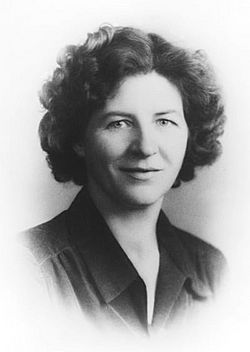Isabel Briggs Myers facts for kids
Quick facts for kids
Isabel Briggs Myers
|
|
|---|---|

Myers in the early 20th century
|
|
| Born |
Isabel Briggs
October 18, 1897 |
| Died | May 5, 1980 (aged 82) |
| Nationality | American |
| Alma mater | Swarthmore College |
| Known for | Myers–Briggs Type Indicator |
| Spouse(s) | Clarence Myers |
| Children | 2 |
| Parent(s) | Lyman James Briggs Katharine Cook |
Isabel Briggs Myers (born Isabel Briggs; October 18, 1897 – May 5, 1980) was an American writer. She is famous for creating the Myers–Briggs Type Indicator (MBTI) with her mother, Katharine Cook Briggs. The MBTI is a very popular personality test used all over the world. More than two million people take this test every year.
Contents
Early Life and Education
Isabel Briggs Myers grew up in Washington, D.C.. Her mother, Katharine Cook Briggs, taught her at home. Her father, Lyman J. Briggs, was a research physicist. Isabel had little formal schooling before attending Swarthmore College. There, she studied political science.
At college, she met Clarence "Chief" Gates Myers, who was studying law. They married in 1918 and stayed together until his death in 1980. Isabel Briggs Myers also passed away in 1980. She left the rights to the MBTI to her son, Peter.
Writing Mystery Novels
In 1928, Isabel Briggs Myers wrote a novel called Murder Yet to Come. She entered it in a magazine contest for murder mysteries. Her book won the contest and was published in parts in 1929. This story used her ideas about different personality types to solve a murder.
Winning the contest also gave her a cash prize and a contract for another book. She wrote a second novel, Give Me Death, which featured the same detectives. This book was published in 1934.
The Myers-Briggs Type Indicator
Why the MBTI Was Created
When World War II began, Isabel Briggs Myers read an article about "fitting the worker to the job." She realized there was a need for a tool to help people find the right jobs. This was especially important as the United States might join the war. She wrote to her mother, Katharine Cook Briggs, about this idea. Her mother was a big fan of Carl Jung's ideas about personality.
Isabel Briggs Myers used Carl Jung's ideas and added her own thoughts. She then created a paper survey. This survey eventually became the MBTI. She and her mother spent 20 years developing this test. It was designed to help people understand their personality type.
How the MBTI Works
Carl Jung's original ideas included three pairs of preferences:
- Extraversion and Introversion (how you get energy)
- Sensing and Intuition (how you take in information)
- Thinking and Feeling (how you make decisions)
Isabel Briggs Myers studied these ideas. She then added a fourth pair: Judging and Perceiving (how you prefer to live your outer life).
Isabel Briggs Myers also said that her marriage inspired her to create the MBTI. She and her husband, Clarence Myers, had different psychological types. This inspired her mother to study how people are different. Her mother then found Carl Jung's work and shared it with Isabel.
Testing and Development
In 1945, the dean of the George Washington School of Medicine allowed Isabel Briggs Myers and her mother to use the MBTI. They tested about 5,500 first-year students. Isabel Briggs Myers studied the results for years. She looked for patterns among students who dropped out and those who succeeded.
The Center for Application of Psychological Type
In 1975, Isabel Briggs Myers helped start the Center for Application of Psychological Type (CAPT). She co-founded it with Mary McCaulley. CAPT is a non-profit group that works to research and use the MBTI. It also aims to protect and promote Isabel Briggs Myers' ideas. Its main office is in Gainesville, Florida. Their motto is "Fostering human understanding through training, publishing, and research."
MBTI Today
As of 2022, research on the MBTI is still ongoing. Many articles are published each year. The Isabel Briggs Myers Memorial Research Awards give money to people who do more research on the MBTI. These awards are given twice a year.
The MBTI is used by many businesses, coaches, and psychologists. However, some academic researchers in psychology do not fully support it. They sometimes see it as a pseudoscience, meaning it might not be based on strong scientific evidence.
Publications
Isabel Briggs Myers wrote several books about personality and her work.
- Gifts Differing: Understanding Personality Type (1980, 1995): This book was written with her son, Peter Briggs Myers. It talks about human personality and how it affects things like careers, marriage, and life's meaning. It explains all sixteen personality types.
- Introduction to Type: A Description of the Theory and Applications of the Myers-Briggs Type Indicator (1990)
- Manual: A Guide to the Development and Use of the Myers-Briggs Type Indicator (1985), with Mary McCaulley.
- Murder Yet to Come (1995): This is her mystery novel.
See also
 In Spanish: Isabel Briggs Myers para niños
In Spanish: Isabel Briggs Myers para niños

